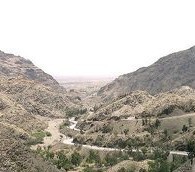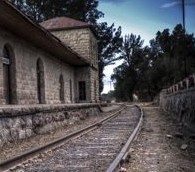Tag: History Travel
American Fool in the Khyber Pass
by Les Braunstein | 07.13.10 | 9:58 AM ET
To impress a girl, Les Braunstein bought a horse in Afghanistan and set out for Pakistan. It was 1971. He was sure he'd be OK.
A Short History of Americans and Brown Sauce
by Eva Holland | 07.08.10 | 1:05 PM ET
Over at The Atlantic’s food channel, Andrew Coe looks into the origins of Chinese brown sauce and the undying American appetite for the stuff. Here’s Coe:
Color matters in Chinese food. You can tell the difference between, say, Sichuan and Cantonese restaurants by the palette of dishes at their tables. Sichuan dishes are often tinted by the red sheen of chili oil, while the many clear sauces of Cantonese cuisine allow the natural colors of meats and vegetables to stand out. But on the steam tables of the more than 40,000 Chinese-American restaurants that dot this land, the predominant color is brown, as in the ubiquitous beef with broccoli drenched in a brown sauce. According to the Chinese food maven Michael Gray, there’s an ancient epigram that describes what these steam tables offer: “100 dishes, all with the same taste.”
Commie Kitsch in Budapest’s ‘Ruin Pubs’
by Rick Steves | 07.07.10 | 11:54 AM ET
Hungary's hottest nightclubs evoke the last days of communism
Of Great Buildings and Tourist Tchotchkes
by Jim Benning | 05.21.10 | 1:11 PM ET
Edward Hollis’s relatively new book—The Secret Lives of Buildings: From the Ruins of the Parthenon to the Las Vegas Strip in Thirteen Stories—is getting some good press. While a post in The New York Review of Books is worth a look, I most enjoyed coming across a 2009 review from the Guardian.
More Tocqueville: James Wood Weighs In
by Michael Yessis | 05.19.10 | 5:05 PM ET
In the New Yorker, Wood immerses himself in two new books about Alexis de Tocqueville and the enduring significance of the Frenchman’s American travels.
Unlike some other European visitors (Charles Dickens and Fanny Trollope, and, more recently, Jean Baudrillard and Bernard-Henri Lévy come to mind), he reserves serious judgment for mortal American sins, not venial ones. His anguish and scorn are provoked not by tobacco-chewing or unreal dentistry but by slavery and the extermination of the Indians. He often teeters on the edge of disdain—as when he notes the poor calibre of American politicians, or the people’s “immense opinion of themselves”—only to find the hospitality of explanation more interesting than the solitude of dismissal. To most non-Americans, American patriotic self-regard can be hard to take (an entire country seemingly innocent of the idea that patriotism is the last refuge of a scoundrel), but Tocqueville is interested in the rationality of American pride, which he sensibly locates in the success, against all odds, of the young democracy.
We noted earlier that Tocqueville might also have been a bad traveler.
In Italy, ‘A Good Restaurant Should Come With a Bed’
by Rick Steves | 05.10.10 | 12:07 PM ET
On a great meal -- and an even better dinner conversation -- in Verona, Italy
Searching for Neal Cassady in San Miguel de Allende
by Peter Ferry | 05.06.10 | 10:48 AM ET
Novelist Peter Ferry hunts down the ghost of the beatnik legend who inspired Kerouac, Ginsberg and so many others
Alexis de Tocqueville: Bad Traveler?
by Eva Holland | 04.19.10 | 11:06 AM ET
A new book on Alexis de Tocqueville’s famous American travels is out. Slate’s Francois Furstenburg parses the new material and takes a second look at the trip that inspired Democracy in America. He writes:
“[W]e learn that Tocqueville would not have made a very good traveling companion. “Repose was contrary to his nature,” [his companion Gustave de] Beaumont later recalled. “The slightest loss of time was unpleasant to him. ... [H]e was always leaving before he arrived.”
The Magic of an Ancient Guidebook
by Eva Holland | 04.16.10 | 9:45 AM ET
NPR commentator Andrei Codrescu is the latest to discover the delights of traveling—whether virtually or in reality—with a decades- or centuries-old guide. His inspiration? Sabine Baring-Gould’s “Castles and Cave Dwellings of Europe,” published in 1911. From the story:
The cave habitats of Europe opened to his erudition and lust are mostly lost now, many devastations later, but they made me hungry and gave me an idea. Why not retro travel?
From the Ostalgia Files: Vita Cola
by Eva Holland | 04.15.10 | 12:42 PM ET
We’ve been covering the ostalgia phenomenon for awhile now, and it’s still going strong. Atlantic food blogger Lauren Shockey has the latest entry in the field, a thoughtful post about her search for GDR-era food brands and products in present-day Berlin. It’s a good read.
The Deceptive Magic of Travel Photography
by Spud Hilton | 04.06.10 | 1:17 PM ET
If you've seen it in a guidebook, that elusive, perfect view must really exist. Right?
Among the Cherry Blossoms in Washington, D.C.
by Rick Steves | 03.30.10 | 2:56 PM ET
Celebrating the arrival of spring and powerful words on a visit to the FDR Memorial
76-Second Travel Show: At the African Burial Ground
by Robert Reid | 03.23.10 | 4:17 PM ET
Robert Reid visits a new museum in New York City and asks, "What took so long?"
Seeking the Holy Grail? Try Valencia.
by Spud Hilton | 03.17.10 | 1:35 PM ET
Breaking news: Spud Hilton has unlocked one of the world's greatest secrets
Travel Ghosts
by Larry Clark | 03.11.10 | 10:21 AM ET
Larry Clark contemplates the power of monuments and memorials -- and the fleeting moments we spend with them
See the full audio slideshow: »
World Travel Watch: Typhoid in Fiji, Khmer Rouge Tourism in Cambodia and More
by Larry Habegger | 03.10.10 | 10:41 AM ET
Larry Habegger rounds up global travel news
San Miguel de Allende: ‘The Loser Now Will be Later to Win’
by Peter Ferry | 02.19.10 | 10:34 AM ET
Peter Ferry celebrates a beloved Mexican city where you might not get all the avocados you want
76-Second Travel Show: A Very Presidential Sandwich
by Robert Reid | 02.17.10 | 5:24 PM ET
Robert Reid celebrates President's Day by chowing down in Chester A. Arthur's one-time bedroom
New Travel Book: ‘China: Museums’
by Eva Holland | 02.05.10 | 12:21 PM ET
This illustrated guide to China’s many lesser-known museums is due out in April. The New Yorker’s Evan Osnos has a thoughtful Q&A with co-author Miriam Clifford, on her favorite spots and the way China presents itself, to visitors and to its own citizens.
76-Second Travel Show: Black History Month in Bed-Stuy
by Robert Reid | 02.03.10 | 11:41 AM ET
Robert Reid heads to the historic Brooklyn neighborhood of Bedford-Stuyvesant









